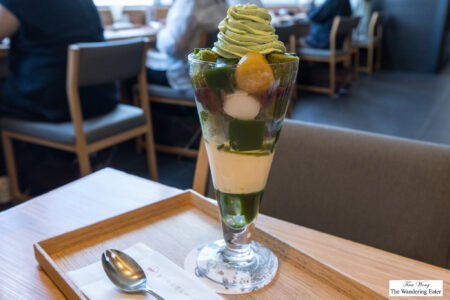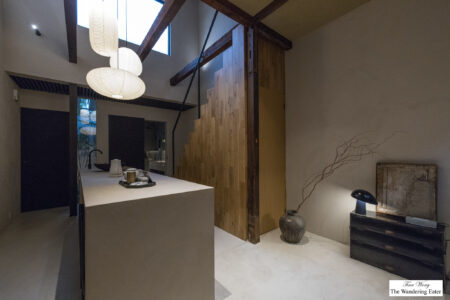In case you haven’t know for many years, I’m a coffee obsessed person. Pretty similar to oenophiles, the pizza snobs, like the writers and readers of Slice, or any other particular food and beverage item that nears obsession to some hearts. Being a devoted consumer of several coffee establishments in New York City like Blue Bottle Coffee, Joe: The Art of Coffee, and Stumptown, the pour-over technique is, or has, become in vogue as of the past year. I’ve bought many cups of coffee brewed this way, including Chemex, and it tastes amazing. The subtle nuances of the beans (fruitiness of a Kenyan, vanilla-cocoa flavors of Ethiopian, etc.) that were sort of muddled in the auto drip version, were cleaner and richer in the pour-over technique.
Recently, I acquired directly from Japan, Hario‘s coffee equipment. I received their well respected V60-02 Ceramic Dripper, Buono kettle, V60 Glass Vessel (Size 2), Skerton Coffee Hand Grinder and the filters for the V60. Hario, as you’ve might have read from the mentioned NY Times article and many other coffee blogs, that it’s the best in the coffee market for drippers. I do own various models of Melitta and used them extensively in the past but the resulting cup is different because of how the coffee is extracted (the internal spiral ridges – aeration of the liquid as it flows out and downward – and the size of its draining hole).
For those who aren’t familiar with this technique, it is low-tech. To condense this to the simplest way possible, all one needs is fresh, roasted coffee beans (the more recent it’s from the roaster, the better your resulting cup), filtered water, scale, measuring cup, your V60 dripper, and your mug (or the V60 vessel as I’m making multiple servings).
Let me place this disclaimer now, I’m still learning the fine art and science of the Hario V60 so I know what I’m dispelling to you what I’ve been doing for the past week is still work in progress.
First thing is to get your water boiling (I used the Buono kettle) and then you grind the coffee beans. I used the finest setting on the Skerton grinder and set aside. The suggested amount of beans is about 10 grams of beans per 4 ounces. Once the grinding is done, I set up the V60 dripper on top of the carafe and insert the paper filter.
Once the water boil, you pour a small amount of water into the empty filter to get rid of the paper taste and discard that water. Add your coffee grounds and about an ounce or two of water until it’s enough to saturate your grounds but does not go over the grounds. You should see the coffee “blooming” and wait. The grounds should look like it’s bulging, expanding, and releasing gases from this initial hit of hot water. This step is essential so there won’t be any dry spots and water channeling.
Once all of the water is drained out and the bloom deflates, you should slowly pour from the center and outward in a tight circular, spiral fashion. Make sure you do not over fill the grounds with water. The key to brewing with the Hario is to keep the grounds wet and the water level even with the grounds at all times during the 2-3 minute brewing process.
When the brewing process is complete the top of your grounds should be flat. Discard the filter and grounds. Enjoy your cup of coffee.
Obviously, not everyone would be inclined to use about 3 to 4 minutes (not including time to heat your water) of your morning to brew coffee. Hardcore coffee lovers like myself would wake up bleary eyed and early for a fantastic cup of coffee. I find it rewarding to drink a very good cup of coffee if there’s effort put behind it and you learn the concept and technique of the pour-over.
I learned from the past week of experimentation, this type of dripper is greatly affected by the size of your coffee grounds due to the size of the hole of this dripper, temperature and timing (with your water pouring technique). I’m still trying to find my “sweet spot” with the fineness/coarseness of my coffee grind and I need to work on my timing as pour since I have yet to taste the similar sublime cup of coffee I get from the coffeehouses when I purchase their pour-over cups.
The best route to get your Hario equipment is from Hario United States, Roustabouts.com, even though I’ve spotted some places in NYC that sells some of their products (like Joe: The Art of Coffee) or of course, Amazon.
Below are Hario USA’s pour-over demonstration (via YouTube) and my photos of Hario’s equipment and my trial of making coffee with the V60:
Slideshow:
[tylr-slidr userID=”” groupID=””]http://www.flickr.com/photos/hellokitty893112/sets/72157625736687988/[/tylr-slidr]






I just wandered over to your blog after finding your
flickr. I can’t wait to look through more of it! Eerie similarities
in that I also had just posted about kin shop and some Hario
equipment are on their way to me right now. I’m excited to try this
method, as I’ve been using a siphon coffee maker on mornings when I
need coffee to get me to the cafe where I get coffee :P and that
takes a good amount of time to prepare too. Anyway, have a great
weekend!
Alice: Coincidence I guess or good tastes think alike? :)
I perused your blog, like your photography very much!